The Writers of the Realist Movement Embraced the Notion That Art Should Depict Life
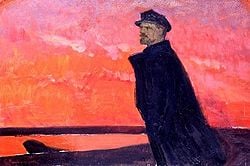
"Lenin in red dawn." Boris Vladimirski.
Socialist realism is a teleologically-oriented way of realistic art which has equally its purpose the furtherance of the goals of socialism and communism. It should not exist confused with social realism, a type of art that realistically depicts subjects of social business concern, although it is related. The original intent of socialist realism was to portray the lower classes of order that had traditionally non been the subject of literature or the arts in general.
What began as an endeavor to describe a new kind of art afterward became the cultural and artistic policy of the Soviet Union to which writers and artists were required to adjust. Every bit socialist realism became state policy, the old censorship of Purple Russia was replaced by a new censorship, every bit fine art that did not conform to state demands was suppressed, and artists who did not comply were silenced.
Socialist realism was the officially approved type of art in the Soviet Marriage for nearly sixty years. Communist doctrine decreed that all material goods and means of product belonged to the customs as a whole. This included works of art and the means of producing art, which were also seen equally powerful propaganda tools. During the Russian Revolution of 1917, the Bolsheviks established a motion called Proletkult (the Proletarian Cultural and Enlightenment Organizations) which sought to put all arts into the service of the dictatorship of the proletariat.
In the early years of the Soviet Union, Russian and Soviet artists embraced a wide variety of art forms nether the auspices of Proletkult. Revolutionary politics and radical not-traditional fine art forms were seen every bit complementary. In fine art, constructivism flourished. Constructivism began with architecture and visual arts. Its principle practitioner was Vladimir Tatlin. It emphasized functionality in grade and efficiency in production. Its utilitarian ethic spread to other art forms, such as poetry and film. The avant-garde journal Lef was associated with this ethic. Important critics, similar Viktor Shklovsky and Osip Brik, promoted practical art over the imagination. The emerging Soviet cinema, which included early film genius Sergei Eisenstein and Dziga Vertov saw the "consciousness-raising" potential of film. In addition to the documentary, Eisenstein's masterpiece, Battleship Potemkin most the Russian Revolution of 1905 was made. In poesy, the nontraditional and the avant-garde were often praised.
The human relationship of the avant-garde and the new Soviet state frayed quickly. Elements of the Communist Party criticized the new experimental art, rejecting modern styles such as impressionism and cubism on the pretext that these movements existed earlier the revolution and hence were associated with "corrupt bourgeois art." Socialist realism was thus to some extent a reaction against the adoption of these new styles that were deemed "corrupt," despite the fact that realism itself was an art form that had also long predated the coming of the communist state. Of course, the nature of realism is not that it depicts what really is. Information technology is an artist motility that used the clarification of the material world to portray individual or social character. The notion of socialist realism was always something of an oxymoron, since the socialist ideals required the depiction non of what was, but what gild should get. This required depicting a "reality" which did not really exist.
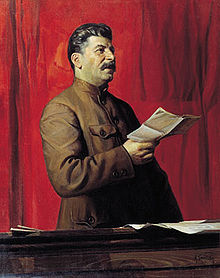
Portrait of Stalin by Isaak Brodsky
Socialist realism became state policy in 1932 when Stalin promulgated the prescript, "On the Reconstruction of Literary and Art Organizations." The Spousal relationship of Soviet Writers was founded to command the output of authors, and the new policy was rubber-stamped at the Congress of Socialist Writers in 1934. Information technology was enforced ruthlessly in all spheres of creative try. Artists who strayed from the official line were severely punished—many were sent to the Gulag labor camps in Siberia and elsewhere.
The restrictions were loosened somewhat subsequently Stalin'southward death in 1953 but the country still kept a tight rein on personal artistic expression. This caused many artists to go into exile, such as the Odessa Grouping from the city of that name. Independently-minded artists that remained continued to experience the hostility of the country. In 1974, for instance, a show of unofficial art in a field most Moscow was cleaved upwardly, and the artworks destroyed, with water cannon and bulldozers. Mikhail Gorbachev's policy of glasnost and perestroika facilitated an explosion of interest in alternative art styles in the late 1980s, but socialist realism remained in force as the official state art mode until as belatedly as 1991. It was non until later on the fall of the Soviet Matrimony that artists were finally freed from state censorship.
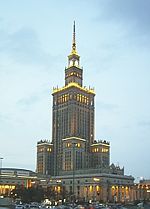
Palace of Civilization and Science in Warsaw.
The Soviet Marriage exported socialist realism to virtually all of the other Communist countries, although the degree to which it was enforced elsewhere varied from country to country. It became the predominant art form across the Communist world for most 50 years.
Today, arguably the only state nevertheless strongly focused on these aesthetic principles is North korea, where, especially in the visual arts, socialist realist principles keep to office as a primary means of propaganda expression. The Prc occasionally reverts to socialist realism for specific purposes, such as idealized propaganda posters to promote the Chinese space program.
Socialist realism had little mainstream impact in the non-Communist globe, where information technology was widely seen as a totalitarian means of imposing country control on artists.
The political aspect of socialist realism was, in some respects, a continuation of pre-Soviet land policy. Censorship and attempts to control the content of art did non brainstorm with the Soviets, but were a long-running characteristic of Russian life. The Tsarist authorities also appreciated the potentially disruptive effect of art and required all books to exist cleared by the conscience. Due to censorship of political ideas, Russian writers and artists in nineteenth century Imperial Russian federation used literature to hash out politics, but they had to go quite skilled at evading censorship past making their points without spelling it out in so many words. Even so, Soviet censors were not and then hands evaded.
Socialist realism had its roots in neoclassicism and the traditions of realism in Russian literature of the nineteenth century that described the life of unproblematic people. It was exemplified by the aesthetic philosophy of Maxim Gorky. The piece of work of the Peredvizhniki ("Wanderers," a Russian realist motion of the late nineteenth and early on twentieth centuries), Jacques-Louis David and Ilya Yefimovich Repin were notable influences.
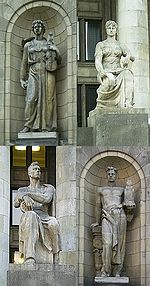
Soc-Realist allegories surrounding the Palace of Civilization and Science in Warsaw.
Socialist realism held that successful art depicts and glorifies the proletariat's struggle toward socialist progress. The Statute of the Union of Soviet Writers in 1934 stated that socialist realism
is the basic method of Soviet literature and literary criticism. It demands of the artist the truthful, historically concrete representation of reality in its revolutionary evolution. Moreover, the truthfulness and historically concreteness of the artistic representation of reality must be linked with the chore of ideological transformation and educational activity of workers in the spirit of socialism.
Its purpose was to elevate the common worker, whether factory or agricultural, by presenting his life, piece of work, and recreation every bit admirable. In other words, its goal was to educate the people in the goals and significant of Communism. The ultimate aim was to create what Lenin chosen "an entirely new type of human being:" Human sovieticus. Stalin described the practitioners of socialist realism as "engineers of souls."
The "realism" attribute should not exist disregarded. Soviet fine art had some continuity to the late 19th century fashion for depicting the social life of the mutual people. Information technology aimed to depict the worker every bit he truly was, carrying his tools. In a sense, the movement mirrors the course of American and Western fine art, where the everyday human being being became the subject of the novel, the play, poetry, and art. The proletariat was at the centre of communist ideals; hence, his life was worthy subject for written report. This was an important shift abroad from the aristocratic art produced nether the Russian tsars of previous centuries. However, it differed in its inclination to romanticize its subject and to portray the society it hoped to create equally a kind of "realism."
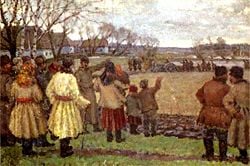
The First Tractor by Vladimir Krikhatsky.
Compared to the eclectic variety of twentieth century Western art, socialist realism often resulted in a fairly bland and anticipated range of creative products (indeed, Western critics wryly described the principles of socialist realism every bit "Daughter meets Tractor"). Painters would draw happy, muscular peasants and workers in factories and collective farms; during the Stalin catamenia, they also produced numerous heroic portraits of the dictator to serve his cult of personality. Industrial and agricultural landscapes were popular subjects, glorifying the achievements of the Soviet economy. Novelists were expected to produce uplifting stories in a manner consequent with the Marxist doctrine of dialectical materialism. Composers were to produce rousing, brilliant music that reflected the life and struggles of the proletariat.
Socialist realism thus demanded close adherence to party doctrine, and has often been criticized as detrimental to the creation of true, unfettered art—or as being piddling more than a means to censor artistic expression. Czeslaw Milosz, writing in the introduction to Sinyavsky's On Socialist Realism, describes the products of socialist realism as "junior," ascribing this as necessarily proceeding from the limited view of reality permitted to creative artists.
Not all Marxists accepted the necessity of socialist realism. Its establishment every bit state doctrine in the 1930s had rather more to do with internal Communist Party politics than classic Marxist imperatives. The Hungarian Marxist essayist Georg Lukács criticized the rigidity of socialist realism, proposing his ain "critical realism" as an alternative. However, such disquisitional voices were a rarity until the 1980s.
Notable works and artists of socialist realism
Saying Gorky'due south novel, Female parent, is usually considered to have been the offset work of socialist realism. Gorky was as well a major factor in the school's rapid ascension, and his pamphlet, On Socialist Realism, essentially lays out the needs of Soviet fine art. Other important works of literature include Fyodor Gladkov'due south Cement (1925) and Mikhail Sholokhov'due south 2 book ballsy, And Quiet Flows the Don (1934) and The Don Flows Home to Ocean (1940).
Although much socialist realist fine art is present widely dismissed as propagandistic rubbish, a number of artists were able to make creative apply of the genre. The painter Aleksandr Deineka provides a notable example for his expressionist and patriotic scenes of the Second World War, commonage farms, and sports. Yuri Pimenov, Boris Ioganson and Geli Korzev take also been described equally "unappreciated masters of twentieth-century realism."
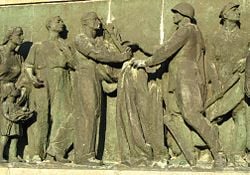
A relief from the Soviet military cemetery in Warsaw showing workers greeting victorious soldiers.
Socialist realism's rigid precepts and enforcement inevitably caused keen damage to the freedom of Soviet artists to limited themselves. Many artists and authors found their works censored, ignored or rejected. The novelist Mikhail Bulgakov, for instance, was forced to write his masterwork, The Master and Margarita, in hole-and-corner, despite before successes, such every bit White Guard. Sergey Prokofiev found himself essentially unable to compose music during this menstruation.
The political doctrine behind socialist realism too underlay the pervasive censorship of Communist societies. Apart from obvious political considerations that saw works such as those of George Orwell being banned, access to foreign fine art and literature was also restricted on aesthetic grounds. Then-chosen "conservative art" and all forms of experimentalism and ceremonial were denounced as corrupt, degenerate and pessimistic, and therefore anti-Communist in principle. The works of James Joyce were specially harshly condemned. The net effect was that it was not until the 1980s that the general public in the Communist countries were able to freely access many works of Western fine art and literature.
References
ISBN links support NWE through referral fees
- Bown, Matthew Cullerne. Art Under Stalin. Holmes & Meier Pub, 1991. ISBN 978-0841912991
- Bown, Matthew, and Matteo Lanfranconi. Socialist Realisms: Bang-up Soviet Painting 1920-1970. Skira6, 2012. ISBN 978-8857213736
- Milosz, Czeslaw. Introduction to On Socialist Realism.
- Sinyavsky, Andrei. The Trial Begins and On Socialist Realism. University of California Press, 1982. ISBN 0520046773.
External links
All links retrieved Nov 16, 2019.
- Socialist Realism Marxists.org
Credits
New World Encyclopedia writers and editors rewrote and completed the Wikipedia commodity in accordance with New World Encyclopedia standards. This article abides by terms of the Creative Commons CC-by-sa 3.0 License (CC-by-sa), which may be used and disseminated with proper attribution. Credit is due under the terms of this license that tin can reference both the New Globe Encyclopedia contributors and the selfless volunteer contributors of the Wikimedia Foundation. To cite this article click hither for a listing of acceptable citing formats.The history of earlier contributions by wikipedians is accessible to researchers hither:
- Socialist realism history
The history of this article since information technology was imported to New World Encyclopedia:
- History of "Socialist realism"
Annotation: Some restrictions may employ to use of individual images which are separately licensed.
Source: https://www.newworldencyclopedia.org/entry/socialist_realism
0 Response to "The Writers of the Realist Movement Embraced the Notion That Art Should Depict Life"
Post a Comment